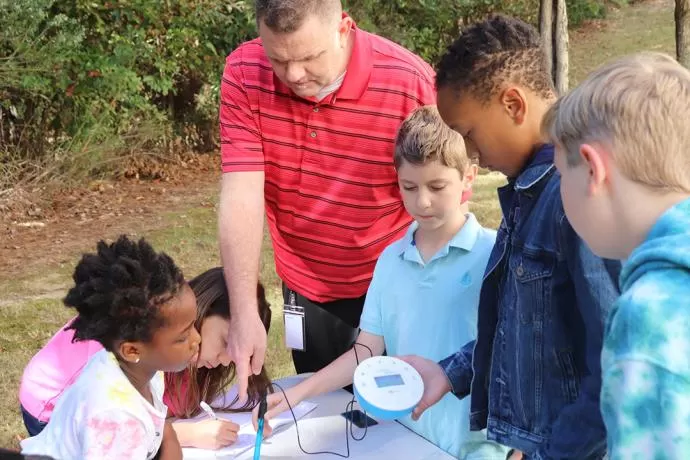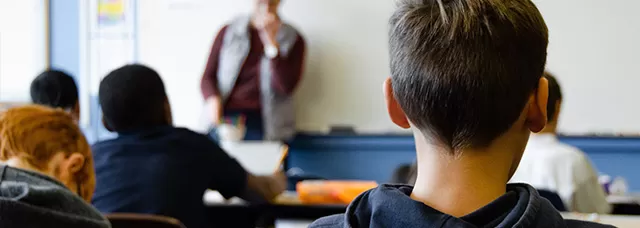Huntington Beach City School District
Preparing Students to Be Ready for Tomorrow’s Workforce
California school district works with Boxlight to transform its classrooms into 21st century learning environments where students are productive, engaged, creative, and ready to succeed in the modern-day workforce.
Installation Snapshot:
• 7 Elementary Schools
• 2 Middle Schools
• 6,800 Students
The Challenge
Knowing that 60 percent of the jobs that elementary school students will fill haven’t even been invented yet, Huntington Beach City School District (HBCSD) is on a mission to prepare those students for successful futures by transforming its classrooms into 21st century learning environments. “If you were in a classroom 10 years ago and told your high school English teacher that you were going to write a blog, your teacher would have looked at you like you’d lost your mind,” says Gregory Haulk, HBCSD’s superintendent. “They would have told you that there was no way you could make a living at it, and to start thinking about writing for a newspaper.”
The problem is that getting teachers and students to think ahead and envision those opportunities requires a forward-thinking, collaborative learning environment enabled by technology—something that HBCSD was missing. To overcome this challenge, the district began searching for the technology partners, tools, and software it needed to change that course. “We were starting from the ground up in all of our classrooms,” Haulk explains. “From the furniture all the way up to the technology itself, all in an attempt to create environments where students feel welcomed, comfortable, and engaged. We want students to be able to walk in and feel like they want to be part of the learning environment.”
“It’s really important we create partnerships with companies that aren’t just there to hand out the next shiny piece of technology, and to truly find technology that’s interactive and easy to use.”
Gregory Haulk, HBCSD’s Superintendent
Developing Critical Thinkers
To fund the effort, the district is using a $160 million bond and the support of its active PTA, which ran a number of fundraisers to support HBCSD’s technology initiative. “For years, our PTA was supplementing and/or completely providing our computers, devices, and technology,” says Haulk. “It was very receptive to listening to what teachers and students wanted and needed.” HBCSD chose OnPoint and Boxlight to be its technology partners for the project, combining OnPoint’s educational expertise with Boxlight’s innovative solutions. OnPoint helps districts and schools achieve their technology goals through the purchase of new technology— such as the offerings from Boxlight—as well as classroom design, professional development, and continued support and service. Working with these partners, the district installed multiple touch projectors in nearly all of its classrooms, where students can work on multiple projects at once and have their work projected on the board.
In another class, you see students using Boxlight’s Labdisc portable STEM lab. Here, third-graders can be found walking around the school taking temperature and humidity readings (both in the classroom and out in the field) to learn about the temperature variations in their environment (e.g., an inland temp in California can reach 110 degrees on the same day that it’s only 75 degrees near the coast). “As adults, we all just call it ‘dry heat,’” says Haulk, “but in reality, the Labdisc technology helps students actually understand the concept of relative humidity versus heat.”
“Technology speeds up the learning process, so it has to be part of everything we do here.”
Gregory Haulk, HBCSD’s Superintendent
Careful Tech Partner Selection
In selecting the right technology partner and products, Haulk says his team looked for a company that would allow the district to get hands-on with the technology before making an investment. HBCSD found exactly what it was looking for in both OnPoint and Boxlight. “I’d never buy a car without test driving it first,” says Haulk, “so it’s nice when you can test out an app or a piece of technology—and turn your students and teachers loose on it—before making a purchasing decision.” Because students will either accept or reject new technology within 10–15 minutes (tops), Haulk says usability is a big consideration for his district. “It’s really important that we create partnerships with companies that aren’t just there to hand out the next shiny piece of technology,” he explains, “and to truly find technology that’s interactive and easy to use.”
The fact that Boxlight’s multiple touch panels and other technology tools are “plug-and-play” also goes a long way in ensuring teacher and student usage. When teachers get frustrated with a new product, for example, that product will likely just end up gathering dust on a classroom shelf. “We pick our partners carefully, and we make sure those partners have product development, product support, and userfriendly interfaces to help even the most technology-averse teacher continue to move forward down the path to the 21st century classroom,” says Haulk.


